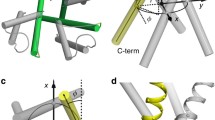Abstract
Collective behaviour of a crown ether channel, bis[(benzo-15-crown-5)-15-yl methyl] pimelate, in a planar lipid bilayer membrane has been studied through electrophysiological methods. A characteristic feature of these channels is their sequential opening, indicated by a uniform stepwise increase in the multi-channel current. The experimental results show that there are three modes of relaxation, of which the slowest one is attributed to the channel–channel interaction. The latter varies with the number of channels incorporated in the bilayer membrane, leading to the interpretation that crown channels behave cooperatively.




Similar content being viewed by others
References
Abel E, Meadows ES, Suzuki I, Jin T, Gokel GW (1997) Unusually long open times, determined by planar bilayer conductance studies for a synthetic tris(macrocycle) that functions as a transmembrane channel in a phospholipid bilayer, JCS Chem Commun 1145–1146
Anderson OS (1999) Graphic representation of the results of kinetic analysis. J Gen Physiol 114:589–590
Bera AK, Ghosh S (2001) Dual mode of gating of voltage-dependent anion channel as revealed by phosphorylation. J Struct Biol 135:67–72
Berrier C, Coulombe A, Houssian C, Ghazi A (1992) Fast and slow kinetics of porin channels from Escherichia coli reconstituted into giant liposomes and studied by patch-clamp. FEBS Lett 306:251–256
Dalley NK (1978) Structural studies of synthetic macrocyclic molecules and their cationic complexes. In: Izatt RM, Christensen JJ (eds) Synthetic multidentate macrocyclic compounds. Academic Press, New York, pp 207–243
Draber S, Schultze R, Hansen UP (1993) Cooperative behaviour of K+ channels in the tonoplast of Chara corallina. Biophys J 65:1553–1559
Gadhiri MR, Granja JR, Buehler LK (1994) Artificial transmembrane ion channels form self-assembling peptide nanotubes. Nature 369:301–304
Gennis RB (1989) Biomembranes molecular structure and function. Springer, Berlin Heidelberg New York, pp129–130, 286–290
Ghosh S (1993) Relaxation of membrane channels: a statistical mechanical approach. J Theor Biol 165:171–176
Ghosh S, Mukherjee A (1993) Statistical mechanics of membrane channels. J Theor Biol 160:151–157
Ghosh S, Bera AK, Das S (1999) Evidence for nonlinear capacitance in biomembrane channel system. J Theor Biol 200:299–305
Ghosh P, Bose D, Ghosh S (2003) Collective behavior of membrane channels: voltage-clamp studies on gap junctions. In: Deutsch A, Falcke M, Howard J, Zimmermann W (eds) Function and regulation of cellular systems: experiments and models. Birkhauser, Basel (in press)
Hille B (1984) Ionic channels of excitable membrane. Sinauer, Boston, Mass., USA, pp 195–201
Kelshian AM, Robert OE, Liu G-J, Madson BW (2000) Evidence for cooperativity between nicotinic acetylcholine receptors in patch clamp records. Biophys J 78:1–12
Langes DA, Trigle DJ (1992) In: Yeagle P (ed) The structure of biological membranes. CRC Press, Boca Raton, Fla., USA, pp 726–732
Mathes A, Engelhardt H (1998) Voltage-dependent closing of porin channels: analysis of relaxation kinetics. J Membr Biol 165:11–18
Neevel JG, Nolte RJM (1984) Ion transport across vesicle bilayers mediated by an artificial channel compound. Tetrahedron Lett 25:2263–2266
Szogyi M, Cserhati T, Tolgyesi F (1993) Effect of some potassium selective crown ethers on the permeability and structure of a phospholipid membrane. Lipids 28:847–851
Szoka F, Papahadjopoulous D (1978) Procedure for preparing liposomes with large internal space and high capture by reverse phase evaporation. Proc Natl Acad Sci USA 75:4194–4198
Valiunas V, Weingart R (2001) Cooperativity between mouse connexin 30 gap junction channels. Pflügers Arch-Eur J Physiol 441:756–760
Vijayvergiya V, Ghosh P, Bera AK, Das S (1999) Bis[(benzo-15-crown-5)-15-ylmethyl] pimelate forms ion channels in planar lipid bilayer: a novel model ion channel. J Physiol Chem Phys Med NMR 31:93–102
Acknowledgements
V.V. thanks the University Grants Commission, Government of India, for the financial assistance. D.B. and P.G. thank the Council of Scientific and Industrial Research for their financial assistance.
Author information
Authors and Affiliations
Corresponding author
Rights and permissions
About this article
Cite this article
Vijayvergiya, V., Bose, D., Ghosh, P. et al. Collective behaviour of crown channels. Eur Biophys J 32, 724–728 (2003). https://doi.org/10.1007/s00249-003-0313-z
Received:
Revised:
Accepted:
Published:
Issue Date:
DOI: https://doi.org/10.1007/s00249-003-0313-z




